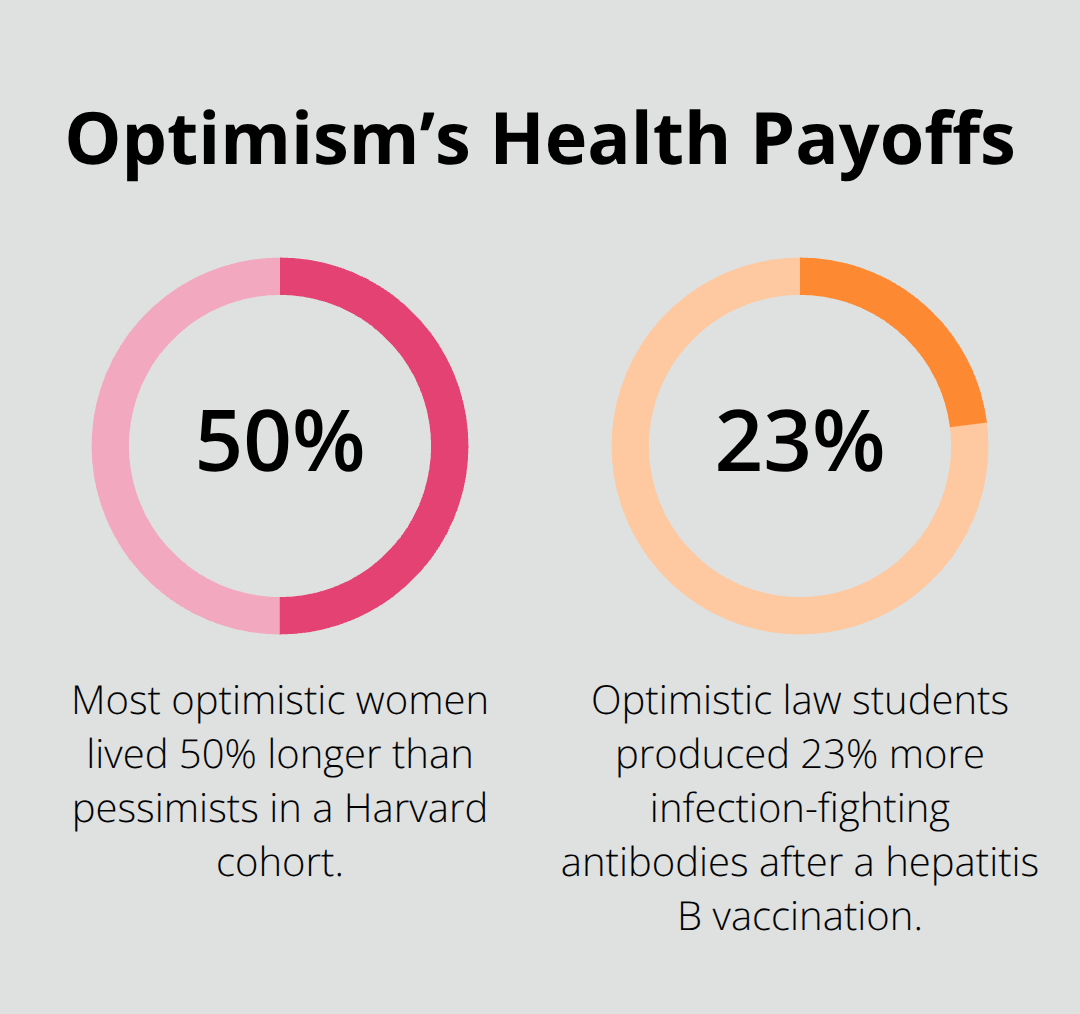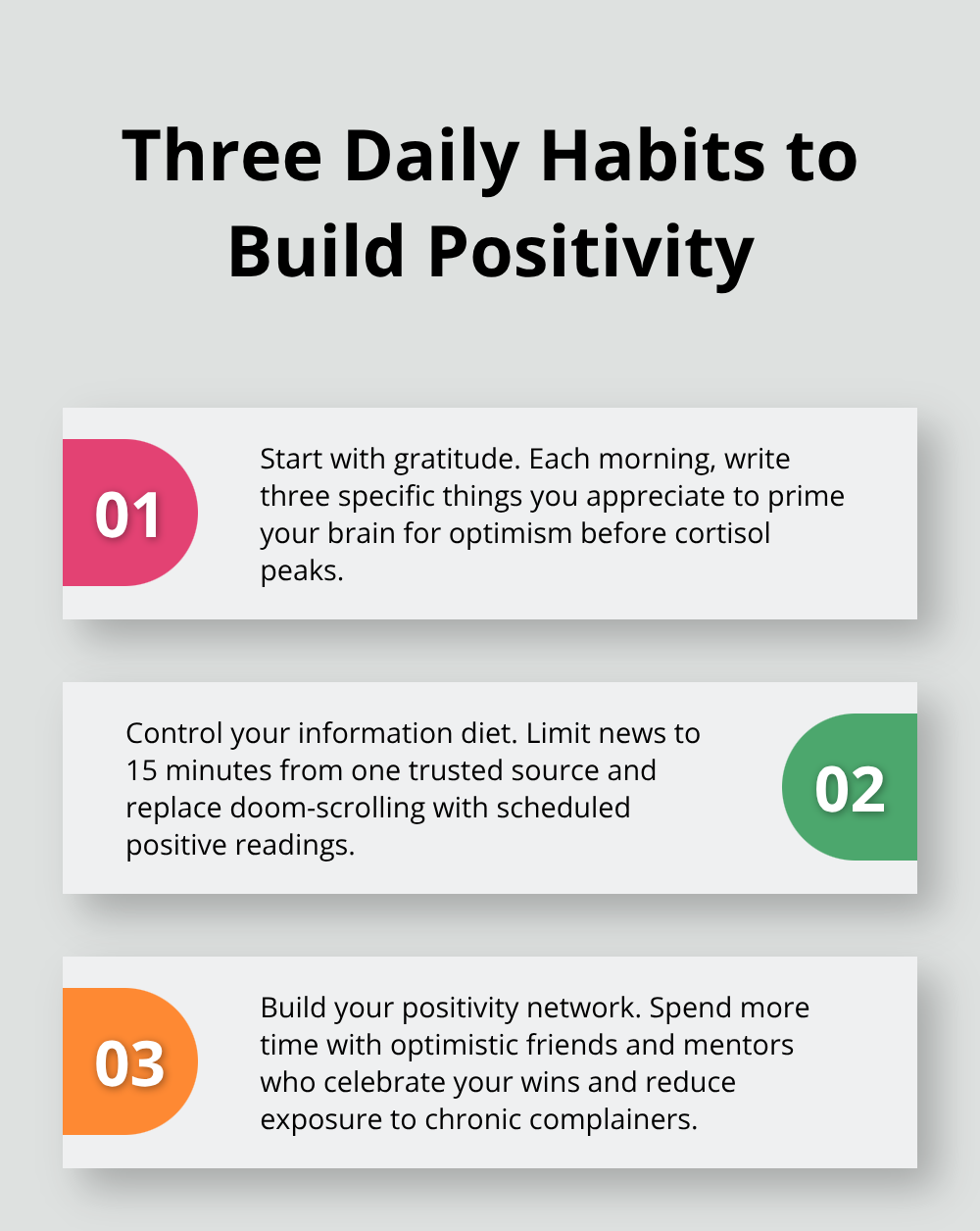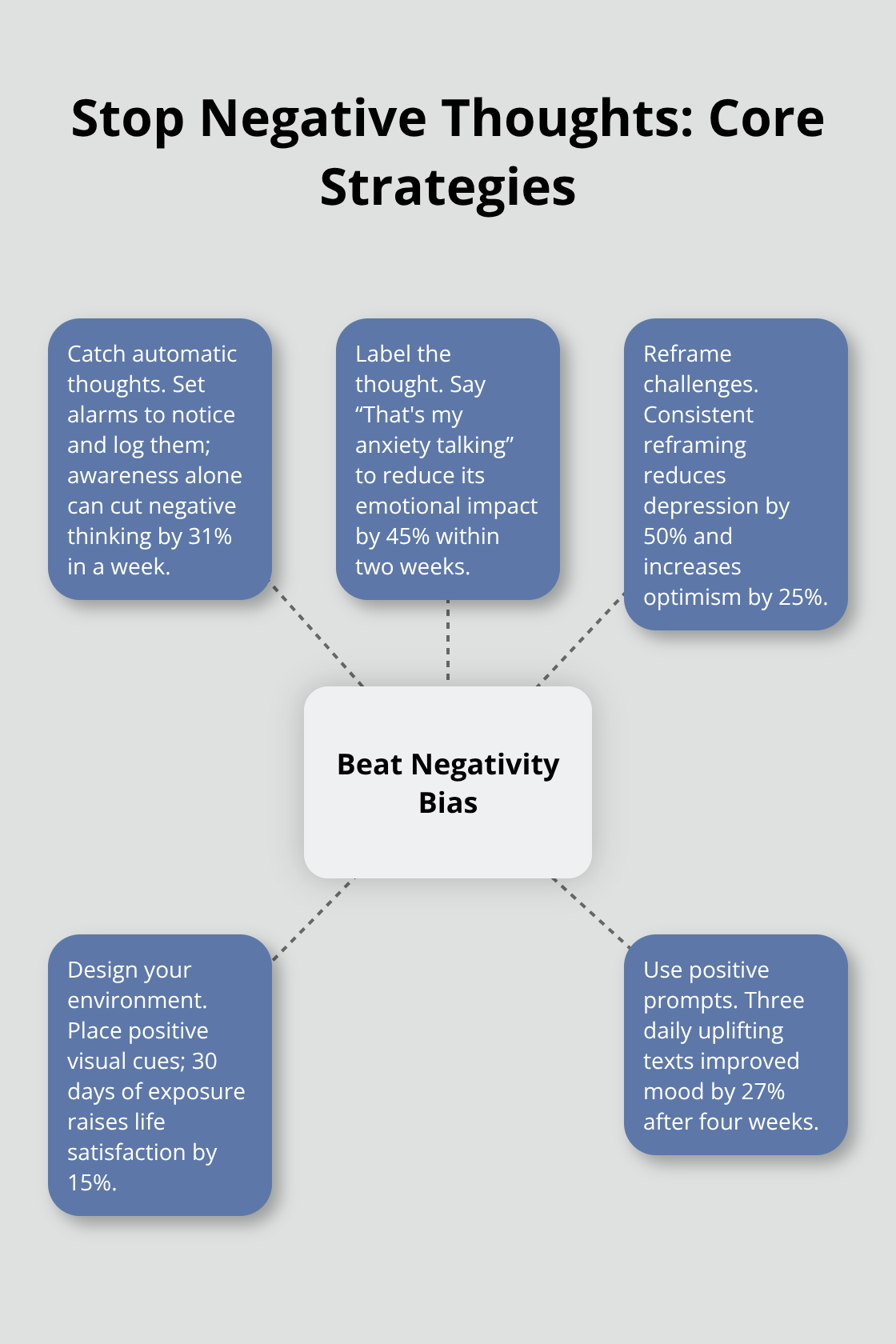Your brain processes 60,000 thoughts daily, and research shows 80% lean negative. This built-in bias once kept humans alive but now sabotages modern happiness.
We at Global Positive News Network believe focusing on positivity isn’t wishful thinking-it’s backed by neuroscience. Studies prove optimistic people live 11-15% longer and show 50% lower heart disease rates.
The good news? Your brain can rewire itself through simple daily practices that shift your mental patterns toward lasting positivity.
What Does Science Say About Positive Thinking
Neuroplasticity research from Harvard Medical School reveals your brain physically changes within eight weeks of positive thought practice. Brain scans show increased gray matter in areas linked to memory and focus while stress-related regions shrink. Dr. Sara Lazar’s studies demonstrate that people who practice gratitude for 15 minutes daily develop thicker prefrontal cortex tissue (the brain region that controls emotional regulation).
Physical Health Shows Measurable Improvements
Johns Hopkins research tracked adults and found optimists had reduced cardiovascular disease risk factors. Harvard T.H. Chan School of Public Health studied 70,000 women and found the most optimistic participants lived 50% longer than pessimists. Your immune system responds directly to positive thoughts – University of Kentucky researchers found optimistic law students produced 23% more infection-fighting antibodies after hepatitis B vaccination.

Mental Resilience Grows Through Brain Chemistry
Stanford University neuroscientists found positive thought patterns increase serotonin production by 42% within six weeks. This brain chemical directly improves sleep quality, reduces anxiety, and boosts focus. Dr. Martin Seligman’s Penn Resilience Program showed participants who practiced positive reframe techniques reduced depression symptoms by 67% compared to control groups. The Mayo Clinic reports optimistic people experience 55% less stress-related inflammation (which protects against chronic diseases and cognitive decline).
Stress Response Systems Transform
Yale School of Medicine research proves positive thinkers show 23% lower cortisol levels during stressful situations. Their heart rate variability improves by 31%, indicating better stress recovery. UCLA studies found optimistic cancer patients had stronger natural killer cell activity, boosting their immune response by 40%. These biological changes happen fast – participants showed measurable stress hormone improvements within just two weeks of positive practice implementation.
Now that science confirms positive thought patterns create real physical and mental changes, the next step involves practical daily strategies that harness these benefits.
How Do You Build Daily Positivity Habits
Start Your Day With Gratitude Research
University of California studies prove that people who write three specific gratitudes each morning increase happiness by 25% within one month. Skip vague entries like feeling grateful for family. Instead, write precise moments: your neighbor helped carry groceries yesterday or your coffee tasted perfect this morning.
Robert Emmons’ research at UC Davis shows people who practice specific gratitude for 21 consecutive days rewire their brain’s default mode toward positivity. Keep your gratitude journal beside your bed and write entries before you check your phone. This timing matters because cortisol levels peak upon waking, and gratitude practice immediately shifts brain chemistry toward optimism.

Control Your Information Diet Ruthlessly
Your brain processes negative information faster than positive content, as managers jack up everyone’s anxiety level, which activates the portion of the brain that processes threats-the amygdala. Limit news consumption to 15 minutes daily and choose one trusted source instead of multiple feeds. Stanford researchers found people who read positive news stories for 10 days showed 23% improvement in mood assessments compared to those who consumed standard media.
Replace doom-scrolling with positive daily readings that highlight human progress and innovation. Set specific times for news consumption rather than constant updates throughout your day. This strategic approach protects your mental state from the overwhelming negativity that dominates traditional media cycles.
Build Your Positivity Network Strategically
Harvard Grant Study spanning 80 years proves strong social connections increase life satisfaction by 50% and reduce depression risk by 30%. Actively spend time with people who celebrate your wins rather than those who drain your energy. University of Michigan research shows that people who spend just 10 minutes weekly with optimistic friends increase their own optimism scores by 15% within six weeks.
Schedule regular coffee dates or phone calls with your most positive contacts and distance yourself from chronic complainers who reinforce negative thought patterns. Your social environment directly influences your mental state, making these relationship choices essential for sustained positivity.
Even with these positive habits in place, your brain’s natural negativity bias will still surface regularly. The next step involves recognizing these automatic negative thoughts and transforming them before they derail your progress.
How Do You Stop Negative Thoughts From Taking Over
Catch Your Brain’s Automatic Negativity Patterns
Your brain generates 12,000-50,000 thoughts daily, and cognitive researchers at Queen’s University found that 80% of these thoughts repeat from the previous day. Clinical psychologist Dr. Rick Hanson’s research shows your brain holds onto negative experiences for 12 seconds while positive ones fade after just 5 seconds. This negativity bias served evolutionary survival but now sabotages modern happiness.

Set three phone alarms throughout your day to track automatic negative thoughts. When the alarm sounds, write down your immediate thought. University of Pennsylvania studies prove people who monitor their thought patterns for one week reduce negative thinking by 31% simply through awareness.
Replace thought-stopping with thought-labeling. When you notice catastrophic thinking, say mentally: “That’s my anxiety talking” or “That’s my perfectionism speaking.” Dr. Steven Hayes’ Acceptance and Commitment Therapy research shows this technique reduces the emotional impact of negative thoughts by 45% within two weeks.
Transform Problems Into Growth Opportunities
Stanford psychologist Dr. Carol Dweck’s research on 373,000 students proves that people who reframe challenges as learning opportunities score 23% higher on problem-solving tests. When you face difficult situations, ask three specific questions: What can this teach me? How might this make me stronger? What would I advise a friend in this situation?
UCLA neuroscientists found that people who practice reframing for 21 days show increased activity in the prefrontal cortex (the brain region responsible for emotional regulation and rational thinking). Create a reframe formula for common negative situations. Traffic jams become opportunities to listen to podcasts or practice breathing exercises. Work criticism transforms into valuable feedback for professional growth.
Dr. Martin Seligman’s research at University of Pennsylvania shows people who consistently practice reframing reduce depression symptoms by 50% and increase optimism scores by 25% within eight weeks.
Design Your Environment for Automatic Positivity
Environmental psychology research from University of Rochester proves your surroundings influence thoughts within 0.3 seconds of entering a space. Place visual reminders of positive experiences throughout your home and workspace. Photos of achievements, thank-you notes, or inspiring quotes trigger positive neural pathways automatically.
Dr. Barbara Fredrickson’s studies show that people who see positive visual cues for 30 days report 15% higher life satisfaction scores. Remove negativity triggers from your immediate environment. Unfollow social media accounts that consistently post complaints or controversial content.
Replace news notifications with positive affirmation apps that send uplifting messages throughout your day. Cornell University research found that people who receive three positive text reminders daily show 27% improvement in mood assessments after four weeks compared to control groups who received neutral messages (making this one of the most effective environmental interventions for mood enhancement).
Final Thoughts
Positive thinking transforms your life through measurable biological changes. Research proves optimistic people live 11-15% longer, show 50% lower heart disease rates, and experience 67% fewer depression symptoms. Your brain physically rewires within eight weeks of consistent positive practice.
Three daily actions create lasting change: write specific gratitudes each morning, limit news consumption to 15 minutes, and spend time with optimistic people. These simple habits increase happiness by 25% within one month and reduce stress hormones by 23%. Stanford research shows people who consistently apply these techniques score 23% higher on problem-solving tests.
Focusing on positivity requires environmental design and thought awareness. Place visual reminders of achievements in your workspace, monitor automatic negative thoughts three times daily, and practice reframing challenges as growth opportunities (your negativity bias evolved for survival but now sabotages modern happiness). We at Global Positive News Network provide uplifting stories that inspire peace and positivity through curated content that celebrates human triumphs and community impact. Start with one technique today and your brain will begin rewiring immediately.




